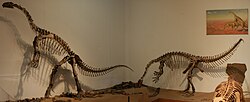Prosauropod
| Plateosaurids Temporal range: Late Triassic, 225–203 Ma |
|
|---|---|
 |
|
| Mounted skeletons of Plateosaurus engelhardti from the Trossingen Formation of southern Germany, mounted in the Institute for Geosciences Tübingen. | |
| Scientific classification | |
| Kingdom: | Animalia |
| Phylum: | Chordata |
| Class: | Reptilia |
| Clade: | Dinosauria |
| Order: | Saurischia |
| Suborder: | †Sauropodomorpha |
| Clade: | †Plateosauria |
| Family: | †Plateosauridae |
| Type species | |
|
Plateosaurus engelhardti von Meyer, 1837 |
|
| Genera | |
| Synonyms | |
|
|
Plateosauridae is a family of plateosaurian sauropodomorphs. Plateosaurids were early sauropodomorph dinosaurs which existed in Asia, Europe and South America during the Late Triassic period. Although several dinosaurs have been classified as plateosaurids over the years, a 2007 study by Adam M. Yates found only Plateosaurus and Unaysaurus valid plateosaurids. In another study, Yates (2003) merged Sellosaurus into Plateosaurus (as P. gracilis). In 2011, Jaklapallisaurus, a plateosaurid from India was named.
Plateosauridae, which was first named by Othniel Charles Marsh in 1895, is a stem-based taxon and it was defined by Sereno, 1998 as all animals more closely related to Plateosaurus engelhardti than to Massospondylus carinatus. Galton and Upchurch, 2004 proposed the following definition: all animals more closely related to Plateosaurus engelhardti than to Massospondylus carinatus and Yunnanosaurus huangi. Yates, 2007 defined it as all animals more closely related to Plateosaurus engelhardti than to Diplodocus longus. Recent cladistic analyses suggest that the clade Prosauropoda, which was named by Huene in 1920 and was defined by Sereno, 1998 as all animals more closely related to Plateosaurus engelhardti than to Saltasaurus loricatus, is a synonym of Plateosauridae as both contain the same taxa. Plateosauridae was recovered as a monophyletic group in the large phylogenetic analysis of early dinosaurs that was presented by Baron, Norman & Barrett (2017) in the journal Nature. In this analysis, the group was found to be sister to Massopoda within the clade Plateosauria.
...
Wikipedia
